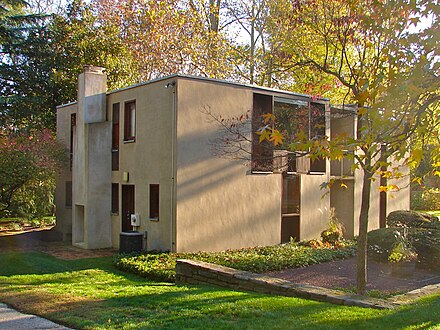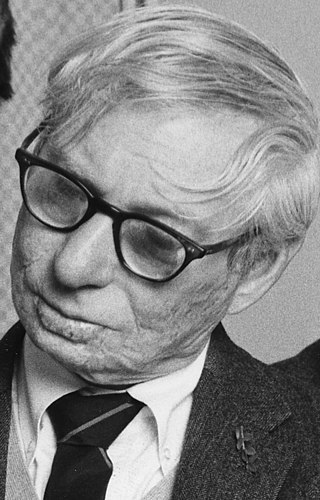
Louis Isadore Kahn was an Estonian-born American architect based in Philadelphia. After working in various capacities for several firms in Philadelphia, he founded his own atelier in 1935. While continuing his private practice, he served as a design critic and professor of architecture at Yale School of Architecture from 1947 to 1957. From 1957 until his death, he was a professor of architecture at the School of Design at the University of Pennsylvania.

The Ward W. Willits House is a home designed by architect Frank Lloyd Wright. Designed in 1901, the Willits house is considered one of the first of the great Prairie School houses. Built in the Chicago suburb of Highland Park, Illinois, the house presents a symmetrical facade to the street. One of the more interesting points about the structure is Wright's ability to seamlessly combine architecture with nature. The plan is a cruciate with four wings extending out from a central fireplace. In addition to stained-glass windows and wooden screens that divide rooms, Wright also designed the furniture for the house.

A Cape Cod house is a low, broad, single or double-story frame building with a moderately-steep-pitched gabled roof, a large central chimney, and very little ornamentation. Originating in New England in the 17th century, the simple symmetrical design was constructed of local materials to withstand the stormy weather of Cape Cod. It features a central front door flanked by multipaned windows. The space above the first floor was often left as unfinished attic space, with or without windows on the gable ends.

The American Foursquare or American Four Square is an American house style popular from the mid-1890s to the late 1930s. A reaction to the ornate and mass-produced elements of the Victorian and other Revival styles popular throughout the last half of the 19th century, the American Foursquare was plain, often incorporating handcrafted "honest" woodwork. This style incorporates elements of the Prairie School and the Craftsman styles. It is also sometimes called Transitional Period.

La Fetra Mansion located in Summit, New Jersey, United States, is a mansion designed and built for industrialist H. A. LaFetra of the Royal Baking Powder Company by Henry Bacon, the same year he founded his architectural firm, Brite and Bacon. He is best known for his last work, the Lincoln Memorial in Washington, D.C. Since its completion in 1899, this mansion has been owned by industry leaders.

The Suntop Homes, also known under the early name of The Ardmore Experiment, were quadruple residences located in Ardmore, Pennsylvania, and based largely upon the 1935 conceptual Broadacre City model of the minimum houses. The design was commissioned by Otto Tod Mallery of the Tod Company in 1938 in an attempt to set a new standard for the entry-level housing market in the United States and to increase single-family dwelling density in the suburbs. In cooperation with Frank Lloyd Wright, the Tod Company secured a patent for the unique design, intending to sell development rights for Suntops across the country.

The Newcomb–Brown Estate is located at the junction of the US 44 highway and Brown Road in Pleasant Valley, New York, United States. It is a brick structure built in the 18th century just before the Revolution and modified slightly by later owners but generally intact. Its basic Georgian style shows some influences of the early Dutch settlers of the region.

The Davenport House, also known as Sans-Souci, is an 1859 residence in New Rochelle, New York, designed by architect Alexander Jackson Davis in the Gothic Revival style. The "architecturally significant cottage and its compatible architect-designed additions represent a rare assemblage of mid-19th through early 20th century American residential design". The house was listed on the National Register of Historic Places in 1980.

The Butterfield Cobblestone House is on Bennett Corners Road in the Town of Clarendon, New York, United States, south of the village of Holley. It is a cobblestone structure from the mid-19th century built in the Greek Revival architectural style by a wealthy local farmer to house his large family. Three generations of his descendants would run the farm over the next 80 years. Later owners would make some renovations to the interior.

The Vanna Venturi House, one of the first prominent works of the postmodern architecture movement, is located in the neighborhood of Chestnut Hill in Philadelphia, Pennsylvania. It was designed by architect Robert Venturi for his mother, Vanna Venturi, and constructed between 1962 and 1964.

The Fisher House, also known as the Norman Fisher House, was designed by the architect Louis Kahn and built for Dr. Norman Fisher and his wife, Doris in 1967 in Hatboro, Pennsylvania. Characterized by its dual cubic volumes, stone foundation and detailed cypress cladding, the Fisher house stands as a clear statement of how Kahn was working at the time, and how his work differed from that of his contemporaries. In the Fisher House, Kahn eschews the linearity of the modern plan and focuses on a simple geometry, allowing the cubes to provide a separation of public and private space.

The Isaac Young House is an historic wood frame house on Pinesbridge Road in New Castle, New York, United States. It was built about 1872 in the Second Empire style. Its owner, Isaac Young, was a descendant of early settlers in the area. He chose the Second Empire style, more commonly found in cities and villages than on farms, possibly as a way of demonstrating his affluence. The present structure appears to incorporate parts of a vernacular late 18th-century farmhouse, leaving several anomalies in the current house as a result. The house's position atop a low hill would have, in its time, given it a commanding view of the region, including the Hudson River and New York City's skyline.
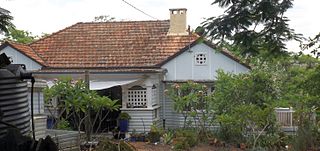
Monkton is a heritage-listed timber-framed domestic house at 7 Ardoyne Road, Corinda, City of Brisbane, Queensland, Australia. It was designed by Elina Mottram and built in 1925 for William and Margaret Dunlop. It is designed by Elina Emily Mottram, who was the first woman in Queensland to establish her own architectural practice. It is historically significant because of its association with the entry of women into the local professions in Queensland, especially so into the architectural profession. It was added to the Queensland Heritage Register on 31 July 2008.

Oak Lodge and Spreydon is a heritage-listed pair of villas at 7 Warra Street & 30 Rome Street, Newtown, Toowoomba, Toowoomba Region, Queensland, Australia. They were designed by architectural firm James Marks and Son and was built from 1890s to c. 1923. They were added to the Queensland Heritage Register on 1 October 2003.
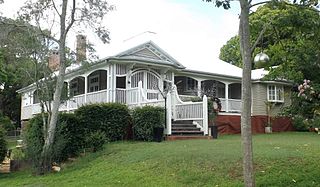
Weemalla is a heritage-listed detached house at 62 Ruthven Street, Corinda, City of Brisbane, Queensland, Australia. It was designed by Robin Dods and built from 1908 to 1909 by Hall and Mayer. It is also known as Steele House. It was added to the Queensland Heritage Register on 9 August 2013.

A byelaw terraced house is a type of dwelling built to comply with the Public Health Act 1875. It is a type of British terraced house at the opposite end of the social scale from the aristocratic townhouse but a marked improvement on the pre-regulation house built as cheap accommodation for the urban poor of the Industrial Revolution. The term usually refers to houses built between 1875 and 1918.

The Second Innisfail Court House is a heritage-listed former court house and police station in Innisfail, Cassowary Coast Region, Queensland, Australia, which was subsequently relocated and used as a private residence at 40 Buckley Street, Yorkeys Knob, Cairns Region, Queensland, Australia. It was designed by Department of Public Works (Queensland) and built from 1920 to 1930s. It is also known as the former Innisfail Police Station. It was added to the Queensland Heritage Register on 6 December 2004.

The Amos Deason Home is located in Ellisville, Mississippi. Completed in 1845, it the oldest home in Jones County, Mississippi and is located at 410 Anderson Street.
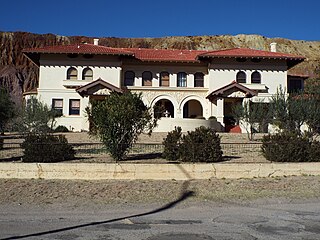
The Walter Douglas House, in Bisbee, Arizona, was built for Walter Douglas in 1908, who was the general manager for the Phelps-Dodge Company. It was the first house built in what was then Warren, Arizona, which was Arizona's first planned community, and was the largest home in the community. Designed by the architectural firm, Trost and Trost, it is a Crafts/Mission Revival Style house. The house has 11 bedrooms, a library, a billiards room, a basement, several school rooms, six fireplaces with Grueby tile, leaded-glass windowns and maple flooring. It also has three apartments ; and 10,000 square feet (930 m2) of patio space. Throughout the years, the house has served several different purposes. Initially it was a private residence for Douglas. Then it was carved into apartments and at one point served as a lodge. In the late 1900s it was renovated as a private residence once again.

The Diamond Rock Schoolhouse is a historic octagonal one-room school located in Tredyffrin Township, Chester County, Pennsylvania. Constructed in 1818, the schoolhouse closed in 1864 and later served as a studio for Wharton Esherick. A local newspapers in 1940 described the schoolhouse as "one of the few remaining octagonal school buildings in Pennsylvania."



